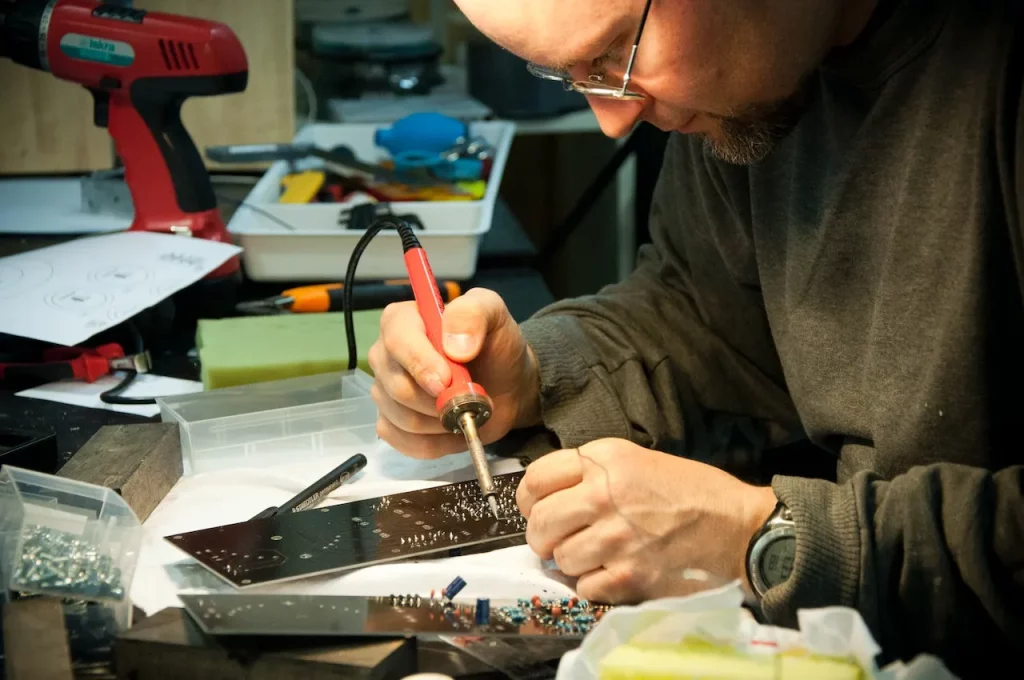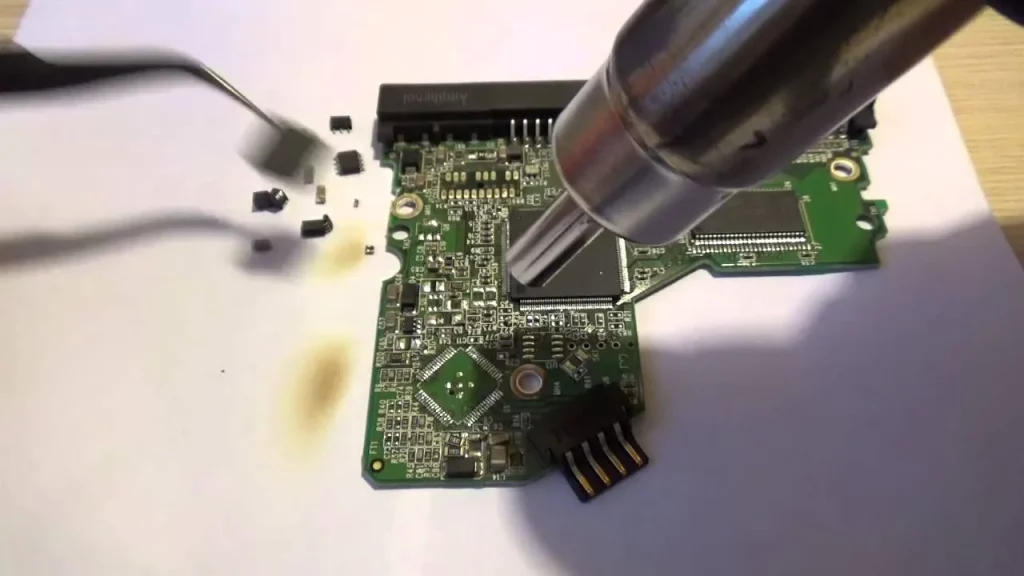The soldier is a type of metal alloy that is used to join electronic components together on a circuit board. It is essential to remove excess solder from a circuit board in order to avoid short circuits and other issues. There are several methods for removing solder from a circuit board, including using a solder wick, a soldering iron, or a desoldering pump.
Note: Before doing any operation please remove the circuit board from the device and place it on a stable and inflammable surface.
How to Remove Solder from Circuit Board Using Soldering Wick
To remove solder from a circuit board using a solder wick, follow these steps:
- Place the circuit board on a stable surface and locate the excess solder that needs to be removed.
- Place the solder wick over the excess solder and hold it in place with tweezers or a clamp.
- Apply heat to the solder wick using a soldering iron. The heat will melt the excess solder and draw it into the wick.
- Continue applying heat until the excess solder has been completely absorbed by the wick.
- Allow the circuit board and the wick to cool down before removing the wick.
Remove Solder Using the Soldering Iron

To remove solder from a circuit board using a soldering iron, follow these steps:
- Place the circuit board on a stable surface and locate the excess solder that needs to be removed.
- Place the tip of the soldering iron over the excess solder.
- Apply heat to the excess solder using the soldering iron. The heat will melt the excess solder.
- Use a pair of tweezers or a clamp to gently remove the excess solder from the circuit board.
- Allow the circuit board and the soldering iron to cool down before removing the tweezers or clamp.
Remove Solder Using the Desoldering Pump

To remove solder from a circuit board using a desoldering pump, follow these steps:
- Place the circuit board on a stable surface and locate the excess solder that needs to be removed.
- For around three minutes, heat the soldering iron. Then, place the hot iron on the surface to be removed. You must continue to heat the iron until all of the solders melts.
- Place the tip of the desoldering pump over the excess solder.
- Press the button on the desoldering pump to create a vacuum and suck up the excess solder.
- Release the button and remove the desoldering pump from the circuit board.
- Repeat the process if necessary to remove all excess solder from the circuit board.
Remove Solder Using the Hot-Air Rework Station

This method is a quick and effective way to remove excess solder without damaging the components on the circuit board. To remove solder from a circuit board using a hot-air rework station, follow these steps:
- Place the circuit board on a stable surface and locate the excess solder that needs to be removed.
- Place the nozzle of the hot-air rework station over the excess solder.
- Adjust the temperature and airflow settings on the hot-air rework station according to the specific requirements of the circuit board and the type of solder being used.
- Apply heat to the excess solder using the hot-air rework station. The heat will melt the excess solder and cause it to flow away from the circuit board.
- Use a pair of tweezers or a clamp to gently remove any remaining excess solder from the circuit board.
- Allow the circuit board and the hot-air rework station to cool down before removing the tweezers or clamp.
- Repeat the process if necessary to remove all excess solder from the circuit board.
A hot-air rework station is a powerful and effective tool for removing excess solder from a circuit board. By following these steps, you can easily remove excess solder from a circuit board using a hot-air rework station. It is important to use the appropriate temperature and airflow settings and to handle the components carefully to avoid damaging the circuit board or causing other issues.
How to remove solder from circuit board without tools
Here, You can use a technique known as “drag soldering.” This involves using the heat from a soldering iron to melt the excess solder and then dragging the iron across the circuit board to remove the excess solder. To remove excess solder from a circuit board using drag soldering, follow these steps:
Place the tip of the soldering iron over the excess solder.
Apply heat to the excess solder using the soldering iron. The heat will melt the excess solder.
Gently drag the soldering iron across the circuit board, using the tip to collect and remove the excess solder.
Repeat the process if necessary to remove all excess solder from the circuit board.
FAQ
How to remove old solder from the circuit board?
To remove old solder from a circuit board, you can use a solder wick, a soldering iron, a desoldering pump, or a hot-air rework station. The specific steps for each method will vary, but the general idea is to apply heat to the excess solder to melt it and then use a tool to remove it from the circuit board. It is important to use the appropriate tools and follow the correct procedure to avoid damaging the circuit board or causing other issues.
How to remove solder flux from the circuit board?
It is easy to remove the flux from a circuit board. To remove solder flux from a circuit board, use a small amount of isopropyl alcohol or another suitable solvent on a clean, soft cloth and gently scrub the excess flux. Use a clean, dry cloth to remove any remaining flux and moisture from the circuit board.
Conclusion
If you guys follow the above methods/ways to remove the solder from the circuit board, you can easily do it yourself. If you need any help please reach us via the comment section. you can easily remove excess solder from a circuit board using a solder wick, a soldering iron, or a desoldering pump. It is important to use the appropriate tools and follow the correct procedure to avoid damaging the circuit board or causing other issues.